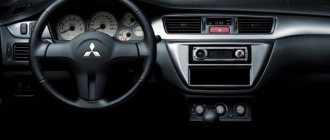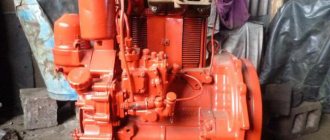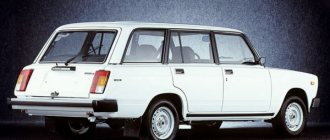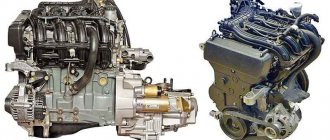Share
Produced since 1982, the Japanese SUV Pajero combines the characteristics of a real all-terrain vehicle and a quiet urban crossover. He is considered a legend in his class. Excellent functionality and pleasant appearance have always attracted the eyes of car enthusiasts to this masterpiece of the automotive industry. The history of the SUV has constantly evolved, so the technical characteristics of the Mitsubishi Pajero will be extremely interesting to consider.
“Pajero” in translation means a wild cat with a persistent character and colossal endurance, living in the vastness of Patagonia, which is located in the southern part of Argentina. However, this name is not used everywhere. In Spanish-speaking countries, the SUV is called "Montero", in the UK - "Shogan", in the USA - Dodge Raider.
The appearance of Pajero 1
Pajero first appeared on camera in 1973, when it was presented at an exhibition in Tokyo.
It was just a concept car with a lot of similarities to Jeep. Almost 8-plus years of waiting and testing of two prototypes convinced Mitsubishi to release a complete analogue of the SUV. The first generation was introduced in 1981, and a significantly improved version became publicly available the following year. Therefore, many sources mark the official start of the release of the cult series as 1982.
At first, SUVs were produced only with a three-door body, a short wheelbase and with two roof options (cast metal and folding).
The range of engines included:
- four-cylinder gasoline engines of 2 and 2.6 liters;
- diesel 2.3-liter unit;
- turbodiesel 2.3-liter engine.
These engines became the basis for the Pajero, and the 6G72 turned out to be so reliable that it is still used in modifications intended for the markets of Japan and a number of countries in the Middle East.
January 1983 marked the debut of the Pajero in the Paris-Dakar rally. At first, the SUV could not compete for the leading positions, but after a number of upgrades the first trophy was taken (1985). Pajero became so good that it went to conquer the markets of Europe and the USA.
In particular, the following fundamental changes were made:
- a new version with five doors and a significantly longer wheelbase appeared in 1983;
- The engines underwent major modifications - 1984;
- The SUV's wheels are equipped with disc brakes instead of drum brakes.
In 1987, the body was covered with better paint, the front seats were heated, and the alloy wheels were increased to 15 inches.
Significant events:
- 1983 - a 9-seater version with a high roof and armored body parts was released (the UN's favorite car);
- 1988 - a 2.5-liter 4D56T turbodiesel unit was released;
- 1990 - the legendary 3.0-liter 6G72 gasoline unit was created;
Together with innovative design solutions (powerful engines, independent front suspension, electric drives), Pajero 1 became a bestseller. It was also warmly received in the foreign market.
| Specifications | |
| Years of production | 1982-1991 |
| Engines | 4G54 4D55 4G63 4G63T 4D55T 6G72 4D56 4D56T 4G64 |
| Transmission | mechanical five-speed automatic, hydromechanical four-speed |
| Weight and dimensions characteristics | length: 4650 mm or 3995 mm width: 1680 mm height: 1850-1890 mm wheelbase: 2698 mm or 2350 mm |
| Tank, liter | 60 or 90 |
Off-road performance
Cross-country ability is the strong point of the IV generation and earlier releases. For this reason, you can ignore the poor quality sound insulation, which was improved by 2015. The runout of brake discs has not gone away after a run of 20-30 thousand km, which is also very familiar to owners of the 3rd generation.
Mitsubishi Pajero: technical characteristics of the engine, dimensions, overhangs of the front and rear bumpers, allow you to drive where other SUVs get stuck at the beginning of the journey. Ground clearance of 235 mm is one of the highest among cars of this class in the factory configuration. In combination with high-quality tires and a smart transmission, the car will overcome any obstacles. Perhaps no one can deny this, because everything has already been proven in practice.
And below is a detailed table with technical characteristics:
Next video about Pajero 4:
You can also read on this topic:
The price list for the updated Russian version of Lifan X60 has been announced
Chip tuning Lexus IS 250: a new image of a sports sedan
Mitsubishi L200 vs Toyota Hilux: who is more reliable?
At the March Geneva Auto Show, the French will show the new Renault Captur
The Japanese demonstrated the restyled Nissan X-Trail
Share on social networks
Alexander Stepanoff March 1, 2017
Posted in: Japanese cars
Tags: SUVs, Crossovers, Japanese cars
Second generation 1991-1999
In 1991, Pajero II was released. The emergence of a strong competitor has shaken up the SUV market. The reason for this was a fundamentally new transmission concept - Super Select 4WD. This system, which controlled the distribution of force between the wheels, opened up new horizons.
The concept of an SUV was largely laid down in the first generation. Then the car simply improved and adapted to car fashion trends. At the peak of the glory of the first generation, it was replaced by the second, which was an excellent marketing ploy.
The body has increased significantly in size. In addition, Pajero 2 received four different versions:
- hardtop;
- folding roof;
- divided into sections;
- cast.
Mitsubishi Pajero 1997 technical specifications
Pajero II was equipped with a third row of seats, adjustable shock absorbers (and the adjustment was made directly from the pilot’s cabin), a winch under the bumper and a hydraulic lift system to change the ground clearance.
After 1991, the SUV developed rapidly:
- engines have been modernized;
- ABS was introduced;
- a choice of rear axle is provided: LCD or with forced locking;
- The second row of seats has been improved.
Also appeared: a central door locking system, an immobilizer, and a power sunroof.
The engine base has been replenished with a 3-liter 12-valve engine with electronic fuel distribution and a 2.5-liter turbodiesel. And in 1993, a 3.5-liter naturally aspirated and a 2.8-liter turbodiesel appeared - both with electronic control.
The second generation was restyled in 1997. Unexpectedly, in 1999, production of Pajero II was discontinued.
The Chinese concern CHANGFENG MOTOR received the right to produce this model. Now the off-road veteran is known as Liebao Leopard, which means "wild cat".
Read more about Pajero 2 here -
| Years of production | 1991-1999 |
| Engines | 6G72 SOHC 12-valve 6G72 SOHC 24-valve 6G72 SOHC 6G72 DOHC 6G72 DOHC GDI 6G72 DOHC MIVEC 4D56 4M40 4M40 EFI 4G54 4G64 |
| Transmission | mechanical five-speed automatic, hydromechanical – four-speed automatic, hydromechanical – five-speed |
| Weight and dimensions characteristics | length: 4705 mm or 4030 mm width: 1695 mm height: 1850-1875 mm wheelbase: 2725 mm or 2420 mm ground clearance: 200-225 mm |
| Tank, liter | 75 or 90 |
The fourth generation is the successor of the third
It is impossible to consider the latest 4th generation car separately from its predecessor. After all, the characteristics of Pajero should only improve from model to model, as well as the reliability of components and assemblies. Indeed, the body of the 3rd generation has become much stiffer. This can be seen in the fourth version, but nothing has changed fundamentally; there is simply no need for it.
An excellent body, assembled using Mitsubishi RISE technology, reliably protects the driver and passenger from all types of impacts. Two zones, created using a special technology, located in front and behind the car body, effectively dissipate kinetic energy in the event of mechanical damage from the outside. A powerful frame made of beams, integrated into the base, creates a safety zone inside the car that will prevent the most serious surprises.
The safety characteristics of the Mitsubishi Pajero have become significantly better. This is a combination of passive and active protection for passengers and the driver in the form of seat belts, front and side airbags.
However, there are still changes. An additional power unit is located under the rear seat. In the front part, the designers changed the angle of the amplifier. The number of welded joints between the side members and the engine shield has increased. Aluminum hood installed. All this led to the fact that the rigidity of the structure increased even more, and control on a flat road at high speeds became significantly better.
The front and rear suspensions were configured differently, all other components, the principle of its operation and design remained unchanged. The car began to overcome road unevenness and off-road conditions more smoothly.
Electronics installed inside the cabin allow you to quickly select the most comfortable driving mode, because it controls the all-wheel drive of the SUV. The SuperSelect transmission is a thing of the past. Pajero 4 technical characteristics are related to the updated, “advanced” Advanced SuperSelect 4WD (SS4-II).
What remains unchanged is the ability to choose. As in the 3rd generation, you can set several different modes:
- rear;
- four-wheel drive;
- all-wheel drive in high range with locked differential;
- all-wheel drive in low range with locked differential.
Third generation 1999-2006
In 1999, the third generation was released. Almost every detail of the SUV has been redesigned. New engines were created:
- petrol 6G74 GDI 3.5 l;
- petrol 6G75 with a volume of 3.8 liters;
- diesel engine 4M41 with a volume of 3.2 liters.
Although the engine base was slightly affected, the electronic equipment was given an innovative shake-up.
The axles on the Pajero III have been removed. The frame was integrated into the body, the wheels were equipped with separate drives, and the suspension was made independent. Compared to previous models, the SUV has become much more comfortable and convenient, and cross-country ability has been improved by refining the Super Select II transmission.
Pajero 2000
The appearance of the third generation of Pajero was marked by a significant redesign of the early models:
- improved handling by shifting the center of gravity to the rear axle;
- improved aerodynamics due to the creation of a new body shape;
- The suspension has been strengthened due to the removal of a reinforced frame.
The all-wheel drive system received a new distribution of torque along the axles in a ratio of 33/67 (advantage to the rear axle). If necessary, the electronics could make the distribution equal between the axes.
| Years of production | 1999-2006 |
| Engines | 6G72 6G74 6G75 4D56 4M40 4M41 |
| Transmission | Mechanical - five-speed automatic, hydromechanical - four-speed automatic, hydromechanical - five-speed |
| Weight and dimensions characteristics | length: 4800 mm or 4220 mm width: 1895 mm height: 1845-1855 mm wheelbase: 2725 mm or 2420 mm ground clearance: 230 mm weight: 2165 kg |
| Tank, liter | 75 or 90 |
Pajero restyling 1997
After 3 years, in 1997, the company made a restyling, maintaining the basic style. The car went on sale on the European continent starting in 1998. The Pajero became more voluminous because it was modified with inflated barrel-shaped wings. Despite this, models with narrow wheels and wings in the previous modification continued to be produced and this car was called Mitsubishi Pajero Classic.
Starting in the fall of 1997, the Pajero began to be equipped with a 3.5 V6 GDI engine.
The trunk is carpeted and even with the seat folded down it is small. This drawback is not present in the five-door versions measuring 4565x1695x1850 mm. Also, the cabin of such a car can easily accommodate up to 5 passengers with a height of 189 centimeters. In addition, there was another version in production: a 7-seater extended Semi High Roof Wagon model measuring 4820 x 1775 x 1850 millimeters.
The instrument panel is rounded and now has no corners. All instruments are clearly distinguishable, and the lighting in the cabin is made taking into account the wishes of car enthusiasts. It is noteworthy that even the pedal assembly is illuminated in the cabin.
The 1997 Mitsubishi Pajero is equipped with an altimeter, thermometer and inclinometer. Thanks to these instruments located at the top of the console. All the heating and ventilation controls are very comfortable, the steering is adjustable and the seat backs are lumbar adjustable.
The windows are controlled by an electric motor, and the sunroof is also opened with a button from inside the cabin. An auxiliary heater warms the rear seats, and its operation can be adjusted by the passengers themselves. All-wheel drive works flawlessly. The car drives straight and handles the road perfectly. The ABS braking system is very effective and precise.
Engine options for 1991 - 1998 models:
- Power - 208 hp, volume - 3.5 liters, 24 valves;
- Power - 177 hp, volume - 3.0 l., 24 valves;
- Power - 150 hp, volume - 3.0 l.;
- Power - 125 hp, volume - 2.8 liters;
- Power - 111 hp, volume - 2.4 liters, turbodiesel;
Fourth generation
The latest generation was introduced in 2006. Significant modernizations affecting it:
- improving the level of security;
- new interior design and interior;
- maximum electronization of vehicle systems;
- improvement of the suspension.
The engine base of the new SUVs is represented by the following models:
- 3.2-liter – diesel, 167 l. With;
- 3.8-liter gasoline engine, 247 hp. With;
- 3.0-liter V-6 from the previous generation (mainly for the domestic market).
In general, the fourth generation was a logical continuation of the third. Its separation into a new branch of development occurred due to the use of more innovative technologies in the creation of an SUV.
| Years of production | 2006-present time |
| Engines | 6G72 6G75 4M41 |
| Transmission | Mechanical - five-speed automatic, hydromechanical - four-speed automatic, hydromechanical - five-speed |
| Weight and dimensions characteristics | length: 4900 mm or 4385 mm width: 1875 mm height: 1880-1900 mm wheelbase: 2780 mm or 2545 mm ground clearance: 230 mm |
| Tank, liter | 75 or 90 |
Minor disappointments
From the previous generation, the disease of the damper screws loosening and getting into the cylinders has passed on. It was solved during maintenance 60 by seating the screws on thread sealants. The 3-liter gasoline engine turned out to be the most durable and omnivorous. It worked productively at low levels, traversed rough terrain perfectly, and could also be “fed” by the AI 92.
When it is necessary to adjust wheel alignment on a car older than 3 years, mechanics are faced with soured adjustment bolts. This surprise is also a legacy from Pajero III. Except how to soak it, and then heat it, and if in vain, then cut it off, it is impossible to “cure the sore”.
The gearbox in all modifications of all years of production on the IV generation Pajero copes with its duties perfectly. Timely oil changes with a filter change at a mileage of 90 thousand km will allow you to operate this unit for as long as possible.
Should we expect the release of the new Pajero?
Many fans of the series are interested in the question: will there be a fifth generation Pajero? With a high degree of probability, Mitsubishi will still release it. Concept cars have already been presented, and it would not be very reasonable to expect new restylings of the 4th generation. The concern has not openly announced the release of Pajero 5, but many factors indicate that this will happen in the coming years.
According to various sources, we managed to find out that the fifth generation Mitsubishi Pajero will have:
- hybrid and more powerful engines;
- increased level of comfort when driving and operating in general;
- modified all-wheel drive system;
- the maximum possible electronicization of all components of the SUV;
- improved cross-country ability;
- more economical and environmentally friendly fuel combustion system.
Read more about the release of the 5th generation here .
Mitsubishi Pajero IO
Mitsubishi Pajero IO
is an all-wheel drive compact SUV produced by Mitsubishi Motors since 1998. It is worth noting that this is not even an SUV in the full sense of the word, but rather a utilitarian city cross-country vehicle.
It is convenient both when traveling outside the city and when maneuvering in cramped urban conditions. This model is especially popular among representatives of the fair half of humanity.
But even men do not hesitate to drive this model, especially the five-door version.
How did this car come into being? At the end of the last century, it became obvious that new compact models were required that combined the ease of operation and comfort of sedans and the off-road efficiency of jeeps. Flexibly responding to the changing situation, Mitsubishi released Pajero IO in 1998.
The famous automotive design studio Pininfarina took an active part in the creation of IO. This model combines compact appearance, practical use of the interior, and comfort when moving off the asphalt.
The mini-SUV immediately gained popularity in its historical homeland, and the world community became more familiar with it at the Geneva Motor Show, where the Pajero Pinin, which is structurally similar to the IO, was demonstrated.
The younger brother of full-fledged SUVs Pajero has completely retained the style of its model range, but on a much smaller area entrusted to it. The shape of the front and rear bumpers has been structurally changed, with virtually no overhang at the rear and a visually noticeable recess has been made for the spare wheel in order to ensure good visibility.
The inner world of Pajero IO is Japanese-style, kind and thoughtful. It would seem that such a baby should have a cramped, uncomfortable interior. But no! The car is roomy and spacious, minimizing the ergonomics of the driver’s seat and the car’s equipment had almost no effect.
Of course, the car is not intended for transporting large groups, but it is quite suitable for a small family. You can seat children in the back or, if you fold down the seats, put luggage. The backrests of the rear seats are each individually adjustable in angle of inclination.
The trunk, which is not very roomy, has an additional underground organizer, and in general, judging by the number of pockets and drawers in the cabin, the Pajero IO can be called a smuggler’s dream.
Mitsubishi Pajero IO is equipped with two types of engines. Two-liter 4G94 with direct fuel injection (GDI) and 136 hp. and 1.8-liter 4G93 (116 hp), with conventional ECI-Multi distributed injection. A more powerful version of the engine can be equipped with a manual transmission, while 1.
The 8-liter comes exclusively with a 4-speed automatic transmission. By the way, GDI series engines are almost environmentally friendly, providing low fuel consumption, they allow the car to respond sensitively to the gas pedal.
The IO has two types of transmission: either FULLTIME 4WD, including the Super Select system, or the Easy-Select system, with all-wheel drive, lockable differentials and a range-shifter.
The fact that the Pajero IO, although small, is still a jeep, had a positive effect on the off-road qualities of the car. The absence of overhangs ensures high-degree angles of approach and descent: 33 and 45, respectively.
An elastic suspension with a long stroke, a good ratio of the length of the car and the base provide comfort when driving off-road and confirm that the IO, although a younger one, is a completely sibling to the adult Mitsubishi Pajero models.
This is a small-sized off-road vehicle, which in many respects is superior to most existing “classmates”.
Next you can see photos of Mitsubishi Pajero IO
different years of manufacture.
Interesting posts
Source: https://catalogcars.net/mitsubishi/mitsubishi-pajero-io-obzor-tehnicheskie.html
SUV prices today
In conclusion, it would not be amiss to consider the price range of the Mitsubishi Pajero on the Russian market. Naturally, like any other car, this SUV can be purchased either new or used.
Depending on the condition and generation, the cost of Pajero varies. On average, SUV prices in 2021 are as follows:
- first generation - from 200-250 thousand rubles;
- second generation - from 250-300 thousand rubles and from 400-500 thousand rubles for restyled models after 1997;
- third generation - from 500-700 thousand rubles;
- fourth generation - from 900 thousand rubles.
This jeep is an amazing example of survivability. It does not become obsolete, it is needed. Against the background of the fact that today the main competitors, such as Land Rover, Toyota Highlander or Nissan Pathfinder, are gradually degenerating, Pajero proudly bears the names “brutal”, “butch”, “truly masculine”. The fact that Pajero has won the prestigious Dakar off-road race 12 times speaks for itself. He began his career as an athlete immediately after his release (in 1985). Much of the rally technology was transferred to civilian models.











